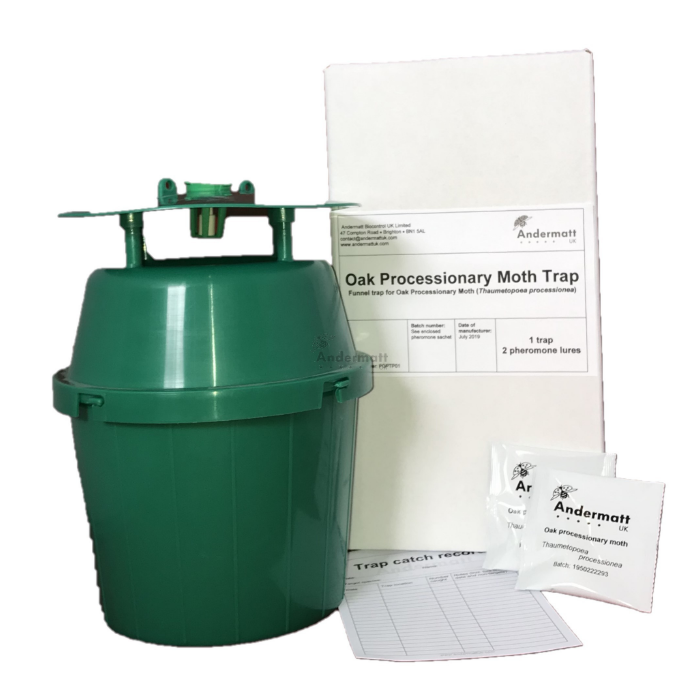Pheromone monitoring traps are a key tool to understand the risk posed by a specific pest population. Oak Processionary Moth (OPM, Thaumetopoea processionea) is an invasive pest to the UK and is spreading within the Greater London area as well as being a risk of further from movement of contaminated imported plant material. Using pheromone traps to catch moths is key to understanding the spread of this invasive pest and identify where further observation efforts should be focussed to help prevent the further spread of this pest.
Pheromone monitoring traps are a relative low cost input and have minimal labour needed for recording and maintenance. Their use supports decisions on where resources should be allocated to carry out visual observations of potential caterpillar activity.
• Identify where Oak Processionary Moth are present and active
• Guide where to concentrate visual observations of oak trees
• Support decisions on where to allocate eradication activities
What are pheromone monitoring traps?
Pheromone traps attract and catch specific insects. Pheromones are one group of semio-chemicals naturally produced by insects to communicate. Pheromones are chemical compounds produced to communicate information relating to reproduction, for example attracting a mate. They are typically, but not exclusively, produced by female insects to attract males and are species specific. Monitoring traps use manufactured pheromone which are carried in a material designed to give gradual and constant release over a period of time.
The Oak Processionary Moth pheromone trap contains a species specific female pheromone used to attract male moths to the funnel trap. Placed in areas of suspected Oak Processionary Moth (OPM) activity, they will attract and catch male moths allowing identification and confirmation of their presence. Although a wide range of pheromone trap designs are available, studies by the Forestry Commission have shown that funnel traps are more successful than Delta traps at catching Oak Processionary Moth.
Pheromone traps to monitor Oak Processionary Moth.
Within the UK there is currently a containment program aimed at preventing the further spread of this pest. More information about this project can be found on the Forestry Commission website here. Because of the risk contact with hairs of the caterpillar poses to the public, when discovered, populations should be destroyed by professionals. Pheromone monitoring traps should be used from July to September to identify if adult moths are active in an area. If moths are caught and positively identified as OPM, Forestry Commission recommends Oak trees within 200 m of the trap are visually examined for signs of caterpillar or silk nest activity. Using pheromone monitoring traps allows better targeting of visual examination efforts.
Best practice for using pheromone traps against OPM:
• Mark on the trap the target pest being caught
• Use 1 trap per target species
• Trap placement: Place 10-15 meters above the ground, within the oak tree canopy
• Trap location: Preferably place on an oak tree in an open area. Place 1 trap per 1-2 hectares spaced at least 50 meters apart
• Trap counting frequency: Every 1-2 weeks
• Use ‘Trap Catch Record’ to record catches and archive to further understand site history
• After recording the number of insects trapped, remove insects from the trap
• Replace lure as frequently as instructed
• Replace water/saline solution at same time as lure, or more frequently if it becomes filled with insects, scales or dirt
• Traps can be used for multiple years. If reused, a trap should be used for the same insect species
How to use pheromone monitoring traps to help reduce the spread of Oak Processionary Moth?
Monitoring for a pest is a cornerstone of any pest containment program. It allows early identification of the presence of the pest and the risk of its spread. Monitoring traps should be used in areas of known activity, expected spread and potential sites of introduction (e.g. oak tree nurseries). If Oak Processionary Moth (OPM, Thaumetopoea processionea) is trapped outside of its current known range, it should be reported to the Forestry Commission, for example via their online reporting system here.
Safety when using pheromone traps against OPM:
• Hairs of the OPM caterpillar cause an allergic reaction when they come into contact with skin. Adult moths may also cause a reaction from these hairs
• Use gloves when handling any moths collected in an OPM pheromone trap
• Oak Processionary Moth caterpillars and silk nests should only be dealt with by qualified professionals
Benefits to the environment.
Oak Processionary Moth (OPM, Thaumetopoea processionea) is an invasive species to the UK. First discovered in the UK in 2006 there is now a containment programme underway to limit its spread. Identifying areas where the pest is active or newly migrated to are essential as part of this process. Setting up and monitoring pheromone traps is significantly less labour intensive than visual scouting for infestations. Using traps to identify where the pest is active allows more focussed visual scouting and eradication treatments.

